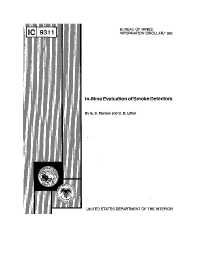Mining Publication: In-Mine Evaluation of Smoke Detectors
Original creation date: January 1992
This report presents the results of a U.S. Bureau of Mines evaluation of smoke detectors placed in conveyor belt entries of underground coal mines. The selected mines are located in six different Mine Safety and Health Administration (MSHA) districts, are operated by seven different companies, and use atmospheric monitoring systems from seven different manufacturers. Principal concerns are early detection and warning of fires, reliability of operation, frequency of maintenance, and adaptability of detectors to monitoring systems and the mining environment. The data contained in this report provide for some comparisons between smoke detectors and CO sensors, specifically in the areas of early detection of fires and susceptibility to nuisance alarms due to diesel exhaust contaminants. Finally, recommendations for performance standards, sensitivity tests, detector classification, and maintenance are presented.
Authors: GS Morrow, CD Litton
Information Circular - January 1992
NIOSHTIC2 Number: 10011225
U.S. Department of the Interior, Bureau of Mines, Information Circular 9311, 1992 Jan:1-13
See Also
- A Comparison of Mine Fire Sensors
- Impact of Air Velocity on the Detection of Fires in Conveyor Belt Haulageways
- In-Mine Evaluation of Underground Fire and Smoke Detectors
- Mine Fire Detection Under Zero Airflow Conditions
- Mine Fire Source Discrimination Using Fire Sensors and Neural Network Analysis
- Multiple Type Discriminating Mine Fire Sensors
- Neural Network Application to Mine-Fire Diesel-Exhaust Discrimination
- Rapid Detection and Suppression of Mining Equipment Cab Fires
- Real-time Neural Network Application to Mine Fire - Nuisance Emissions Discrimination
- Technology News 498 - Multiple Fire Sensors for Mine Fire Detection and Nuisance Discrimination
- Content source: National Institute for Occupational Safety and Health, Mining Program


 ShareCompartir
ShareCompartir
